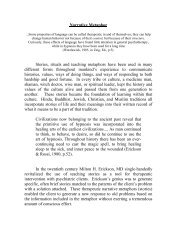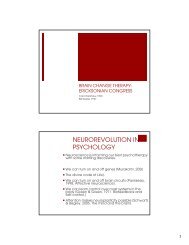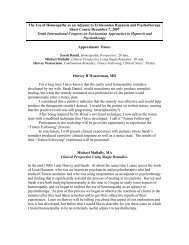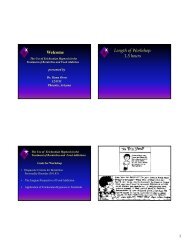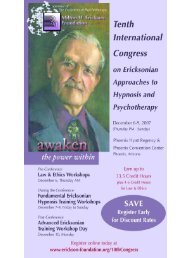Tools for Transforming Trauma - The Eleventh International Erickson ...
Tools for Transforming Trauma - The Eleventh International Erickson ...
Tools for Transforming Trauma - The Eleventh International Erickson ...
Create successful ePaper yourself
Turn your PDF publications into a flip-book with our unique Google optimized e-Paper software.
could be a squeeze of the wrist, a fist, or an OK sign. Whatever he would like to create. Make<br />
sure the patient is still strongly in the positive state. Have the patient make the “positive button”.<br />
You can also repeat the auditory label that they created.<br />
4) Have the patient establish a doubly dissociated point of view.<br />
Specifically, have patient imagine himself sitting in a movie theater. It should not be a very good<br />
movie theater, other than very com<strong>for</strong>table seats. It is small screen and poor sound. <strong>The</strong> person<br />
should imagine that he and you are sitting about two thirds of the way back. Ask the patient to<br />
tell you once he has this in mind. <strong>The</strong>n have the patient imagine himself floating up to the<br />
projection booth or off to the side even further back so that he can see you and him sitting<br />
together watching the blank screen. This double dissociation allows <strong>for</strong> a great deal of safety. It<br />
is also symbolic of creating an observing self that can see the patient in a therapeutic relationship<br />
with the therapist. You can also establish an anchor <strong>for</strong> this state by tapping on a table or<br />
snapping your fingers.<br />
5) Re-Condition the SoC’s linked to the trauma. At this point the patient is now up in the<br />
projection booth watching himself sitting with you com<strong>for</strong>tably. He should also be feeling the<br />
resourceful state of mind both in the booth and in the chair. <strong>The</strong> goal is to hold these states<br />
constant while the patient reviews the trauma. <strong>The</strong> patient is instructed to keep the resource SoC<br />
constant while he watches the trauma from beginning until he gets to the point after the traumatic<br />
event is over. <strong>The</strong> patient is told to use his “positive button” to strengthen the resource whenever<br />
he needs to. <strong>The</strong> patient can be told that he can watch the movie at a very fast speed if he<br />
wants. He can watch the movie more than once if he needs to. <strong>The</strong> suggestion is given that<br />
somehow the patient will know when he is finished. While the movie is running the therapist<br />
must rein<strong>for</strong>ce the positive SoC with verbal suggestion. <strong>The</strong> therapist wants to keep the patient<br />
associated to the resource SoC, in the current year, to the current aged self. To do this the<br />
following language is used:<br />
"as you continue up in the projection booth feeling "resource label" watching you and me sitting<br />
here feeling "resource label" in 2005 ( current year) watching what the younger you went through<br />
back then..."<br />
While the patient watches the movie the therapist can suggest that he may notice<br />
something different that he had not realized be<strong>for</strong>e, or he may have a new perspective on what<br />
happened since He is reviewing this event in this new way. It can be helpful to underscore that<br />
this may be the first time that he has been able to acknowledge the trauma without being in it.<br />
It is imperative that the therapist keeps watching the patient <strong>for</strong> signs of trouble<br />
and not allow him to fall back into the traumatic feelings/experiences. If at any time the<br />
patient starts to develop the traumatic experience, rein<strong>for</strong>ce the dissociation or resource anchor.<br />
If that does not work, use sub-modalities to reduce the affect by making the movie farther away or<br />
smaller or black and white. Sometimes it is enough to just remind the patient not to associate<br />
into the movie. If this does not work stop the treatment. You will need to go back to the drawing<br />
boards. See the following section on trouble shooting TRC.<br />
6) Re-valuing the self: When patient finishes watching the old experience (he may need to<br />
watch more than one time- This is a matter of clinical acumen and the patient's own desires) -<br />
Release the dissociation cue and instruct patient to float back to his or her body. Have patient<br />
from the here and now resourceful position look at younger self at the end of the trauma. Have<br />
the patient walk down to the movie screen. Ask the patient to do one of the following things:<br />
either a) step into the picture or b) bring the younger self off the screen, or c) just talk to the<br />
younger self on the screen.<br />
Instruct the patient to tell the younger self whatever, "he needs <strong>for</strong> healing". In some<br />
cases the patient can be left completely on their own to say what they need to say to himself. It is<br />
often helpful to offer some possible things to say. <strong>The</strong>se can include: a) the patient is from the<br />
future and is living proof that the younger person survived, b) that he made the best choice<br />
© All rights reserved <strong>Tools</strong> <strong>for</strong> Trans<strong>for</strong>ming <strong>Trauma</strong><br />
Dr Robert Schwarz 610-642-0884 doctorbob1000@msn.com page 14 of 14




